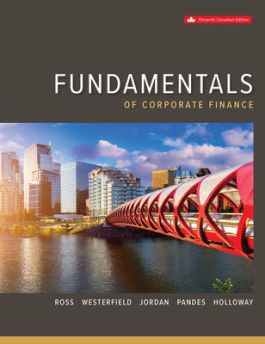Fundamentals Of Corporate Finance
Receive via shipping:
Colour, print bound version of the complete text
1. Introduction to Corporate Finance
2. Financial Statements, Cash Flow, and Taxes
PART 2 Financial Statements and Long-Term Financial Planning
3. Working with Financial Statements
4. Long-Term Financial Planning and Corporate Growth
Appendix 4A: A Financial Planning Model for the Hoffman Company (Available on Connect) Appendix 4B: Derivation of the Sustainable Growth Formula (Available on Connect)
PART 3 Valuation of Future Cash Flows
5. Introduction to Valuation: The Time Value of Money
6. Discounted Cash Flow Valuation
7. Interest Rates and Bond Valuation Appendix 7A: Managing Interest Rate Risk Appendix 7B: Callable Bonds and Bond Refunding (Available on Connect)
8. Stock Valuation
PART 4 Capital Budgeting
9. Net Present Value and Other Investment Criteria Appendix 9A: The Modified Internal Rate of Return
10. Making Capital Investment Decisions
Appendix 10A: More on Inflation and Capital Budgeting
Appendix 10B: Capital Budgeting with Spreadsheets
Appendix 10C: Deriving the Tax Shield on CCA Formula
11. Project Analysis and Evaluation
PART 5 Risk and Return
12. Lessons from Capital Market History
13. Return, Risk, and the Security Market Line Appendix 13A: Derivation of the Capital Asset Pricing Model
PART 6 Cost of Capital and Long-Term Financial Policy
14. Cost of Capital Appendix 14A: Adjusted Present Value Appendix 14B: Economic Value Added and the Measurement of Financial Perfomance
15. Raising Capital
16. Financial Leverage and Capital Structure Policy
Appendix 16A: Capital Structure and Personal Taxes
Appendix 16B: Derivation of Proposition II (Equation 16.4)
17. Dividends and Dividend Policy
PART 7 Short-Term Financial Planning and Management
18. Short-Term Finance and Planning
19. Cash and Liquidity Management
Appendix 19A: Cash Management Models (Available on Connect)
20. Credit and Inventory Management Appendix 20A: More on Credit Policy Analysis (Available on Connect)
PART 8 Topics in Corporate Finance
21. International Corporate Finance
22. Leasing
23. Mergers and Acquisitions
PART 9 Derivative Securities and Corporate Finance
24. Enterprise Risk Management
25. Options and Corporate Securities
26. Behavioural Finance: Implications for Financial Management
Appendix A: Mathematical Tables (Available on Connect)
Appendix B: Answers to Selected End-of-Chapter Problems (Available on Connect)
The Eleventh Edition has been updated to provide current, real world examples, and a wealth of new problem material.
Meeting you and your students where you are.
Using a personalized approach to teaching and learning, Connect is powered by adaptive technologies so your students learn more efficiently, retain more and achieve better outcomes and you can provide the engagement and expertise for more 'aha' moments.
The Eleventh Canadian Edition is current, practical, and builds upon the foundations laid out by this impressive market leader. In addition to retaining the coverage that has characterized Fundamentals of Corporate Finance from the very beginning, the Eleventh Canadian Edition features increased Canadian content on current issues.
With a new Canadian author team, led by J. Ari Pandes and Thomas Holloway, this edition offers an impressive mix of practical and real-world experience. Having an author team that has taught both at the “junior” and “senior” levels in corporate finance courses provides a good balance between application and theory.
Especially notable for this Canadian edition is the Accelerated Investment Incentive that replaces the "half-year rule" in Capital Cost Allowance (CCA). This new policy is reflected in the text, examples, and solutions to end-of-chapter problems.
Integrated Excel® The power of Microsoft Excel® meets the power of Connect in the Integrated Excel® assignments. In this new assignment type, Excel® opens seamlessly inside Connect, with no need for uploading or downloading any additional files or software. Instructors choose their preferred auto-graded solution, with the option for either grading for formula accuracy or for the solution value.
Application-Based Activities Highly interactive and automatically graded application- and analysis-based exercises wherein students immerse themselves in a business environment, analyze the situation, and apply their knowledge of business strategies. Students progress from understanding basic concepts to assessing and solving complex real-world scenarios.
MARKET LEADER. Ross Fundamentals of Corporate Finance continues its tradition of excellence that has earned its status as market leader, offering breadth of coverage and flexibility in organization. Three powerful ideas are integrated throughout – emphasis on intuition, unified valuation approach, and managerial emphasis.
EMPHASIS ON INTUITION. Ross separates and explains the principles at work on an intuitive level before launching into any specifics. The underlying ideas are discussed, first in very general terms and then by way of examples that illustrate in more concrete terms how a financial manager might proceed in a given situation.
UNIFIED VALUATION APPROACH. Net present value (NPV) is treated as the basic concept underlying corporate finance. Every subject covered in Fundamentals of Corporate Finance is firmly rooted in valuation, and care is taken throughout the text to explain how particular decisions have valuation effects.
MANAGERIAL FOCUS. Throughout the text, the role of the financial manager as decision maker is emphasized, and the need for managerial input and judgment is stressed.
WEALTH OF PROBLEM MATERIAL. Ross includes a variety of problem material to support student learning including end-of-chapter Questions and Problems – labelled by topic and separated into 3 learning levels: Basic, Intermediate, and Challenge; Integrative Mini Cases – longer problems that integrate a number of topics within the chapter, and Internet Application Questions – questions that encourage students to explore using the internet.

